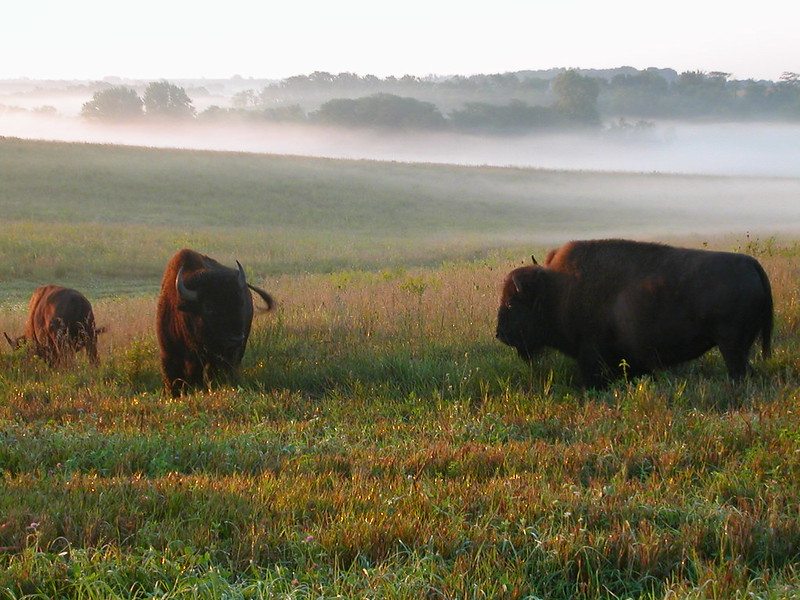The Trilateral Committee Strengthens Ecocultural Conservation of the American Bison Across North America
Canada, Mexico, and the United States care deeply about the American bison (Bison bison), now they have an instrument to work together. Working together through the Canada/Mexico/United States Trilateral Committee for Wildlife and Ecosystems Conservation and Management (Trilateral Committee), Parks Canada, Environment and Climate Change Canada, the Ministry of Environment and Natural Resources of the United Mexican States, and the U.S. Department of the Interior are renewing their commitment to the conservation and restoration of the species across North America by signing a collaborative Letter of Intent (LOI)
The LOI was endorsed during the recent Trilateral Committee meeting in San Diego, California. It underscores a shared commitment to restoring ecological processes and supporting the traditional human use of natural resources, particularly highlighting the deep historical and cultural connection between bison and Indigenous peoples.
Recognizing Historical and Cultural Significance
The American bison once thrived in vast numbers across North America. Before European settlement, bison populations ranged from the desert grasslands of northern Mexico through Canada, to interior Alaska. Due to extensive hunting and habitat loss, their numbers dwindled from an estimated 60-80 million to just 1,000. However, through significant conservation efforts, several protected founding populations have been established, ensuring the species’ survival.
Current Conservation Status and Challenges
Today, approximately 31,000 bison are being stewarded by Canada, Mexico, and the United States with the goal of conserving the species and their role in the function of native grassland systems, as well as their place in Indigenous culture. Despite these efforts, many herds remain isolated and limited by human tolerance, raising concerns about their genetic integrity and long-term viability. Bison occupy only 1% of their historical range, impacting grassland dynamics, plant ecology, bird communities, insect diversity, nutrient cycling, and carbon sequestration.
Ecocultural Conservation Approach
Emphasizing an ecocultural conservation approach, the strategy addresses both ecological and cultural objectives. This approach recognizes the intertwined histories of bison and Indigenous peoples, whose cultures have been shaped by their interactions with this keystone species. Although the recovery of the bison is a significant conservation success, they are still not fully reintegrated into grassland ecosystems or the human cultures with which they evolved. Advancing bison restoration in grasslands is also important for improving soil health, restoring native plants and wildlife, and promoting carbon sequestration. These efforts will reestablish bison populations and their ecological roles, while also supporting Indigenous traditions and communities that have historically depended on bison. Many species benefit from bison habitats, including prairie dogs, which thrive in the short grass areas maintained by bison grazing. Grasslands birds like the burrowing owl and various pollinators also flourish in these ecosystems, relying on the diverse plant life and open spaces that bison help create.
Strengthening Collaboration
Building on successful collaborative efforts, Canada, Mexico, and the United States intend to:
- Enhance collaboration on the conservation and restoration of American bison across the three countries, respecting each country’s national laws.
- Promote regional activities that support ecocultural conservation policies and practices.
- Foster transparency and share technical information developed through joint efforts.
- Develop joint work plans within the Trilateral Committee’s Species of Common Conservation Concern Working Table for review by the Committee’s Executive Working Table.
- Share progress reports on activities conducted under this LOI with the Trilateral Committee’s Executive Table for review.
Commitment to Long-Term Viability
Advancing the long-term recovery of bison in North America is crucial. This collaboration seeks to enhance coordination, share information, and develop specific agreements to further ecocultural conservation goals. By working together with Indigenous peoples, who hold traditional knowledge and cultural connections to the bison, Canada, Mexico, and the United States aim to ensure the survival and ecological role of the American bison for future generations.
Partners

Featured Projects
- Coming soon
For more information please contact:
Canada: Gregory Wilson, Parks Canada
[email protected]
Mexico: Jose Eduardo Ponce Guevera, National Commission of Protected National Areas
[email protected]
United States: Dr. Brendan Moynahan, U.S. National Park Service
[email protected]

